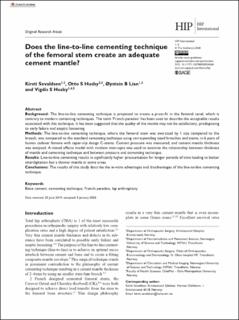| dc.contributor.author | Sevaldsen, Kirsti | |
| dc.contributor.author | Husby, Otto Schnell | |
| dc.contributor.author | Lian, Øystein Bjerkestrand | |
| dc.contributor.author | Husby, Vigdis Schnell | |
| dc.date.accessioned | 2021-09-23T09:27:22Z | |
| dc.date.available | 2021-09-23T09:27:22Z | |
| dc.date.created | 2020-06-10T14:55:09Z | |
| dc.date.issued | 2020-06-18 | |
| dc.identifier.citation | HIP International. 2020, 1-6. | en_US |
| dc.identifier.issn | 1120-7000 | |
| dc.identifier.issn | 1724-6067 | |
| dc.identifier.uri | https://hdl.handle.net/11250/2780723 | |
| dc.description.abstract | Background: The line-to-line cementing technique is proposed to create a press-fit in the femoral canal, which is contrary to modern cementing techniques. The term ‘French paradox’ has been used to describe the acceptable results associated with this technique. It has been suggested that the quality of the mantle may not be satisfactory, predisposing to early failure and aseptic loosening. Methods: The line-to-line cementing technique, where the femoral stem was oversized by 1 size compared to the broach, was compared to the standard cementing technique using corresponding sized broaches and stems, in 6 pairs of human cadaver femora with taper-slip design C-stems. Cement pressure was measured, and cement mantle thickness was analysed. A mixed effects model with random intercepts was used to examine the relationship between thickness of mantle and cementing technique and between pressure and cementing technique. Results: Line-to-line cementing results in significantly higher pressurisation for longer periods of time leading to better interdigitation but a thinner mantle in some areas. Conclusions: The results of this study describe the in-vitro advantages and disadvantages of the line-to-line cementing technique. | en_US |
| dc.description.sponsorship | The Liaison Committee for Education, Research and Innovation in Central Norway, Norwegian University of Science and Technology (Grant number 46055500-6) and Research Department, Møre og Romsdal HF Health Trust. | en_US |
| dc.language.iso | eng | en_US |
| dc.publisher | SAGE Publications | en_US |
| dc.relation.ispartofseries | HIP International; | |
| dc.relation.uri | https://journals.sagepub.com/doi/10.1177/1120700020934368 | |
| dc.rights | Navngivelse 4.0 Internasjonal | * |
| dc.rights.uri | http://creativecommons.org/licenses/by/4.0/deed.no | * |
| dc.subject | French Paradox | en_US |
| dc.subject | Hip Arthroplasty | en_US |
| dc.subject | Bone cement | en_US |
| dc.subject | Cementing techniques | en_US |
| dc.title | Does the line-to-line cementing technique of the femoral stem create an adequate cement mantle? | en_US |
| dc.type | Peer reviewed | en_US |
| dc.type | Journal article | en_US |
| dc.description.version | publishedVersion | en_US |
| dc.rights.holder | © The Author(s) 2020 | en_US |
| cristin.ispublished | true | |
| cristin.fulltext | original | |
| cristin.qualitycode | 1 | |
| dc.identifier.doi | https://doi.org/10.1177/1120700020934368 | |
| dc.identifier.cristin | 1814852 | |
| dc.source.journal | HIP International | en_US |
| dc.source.pagenumber | 1-6 | en_US |
| dc.relation.project | Samarbeidsorganet mellom Helse Midt-Norge og NTNU: 46055500-6 | en_US |

